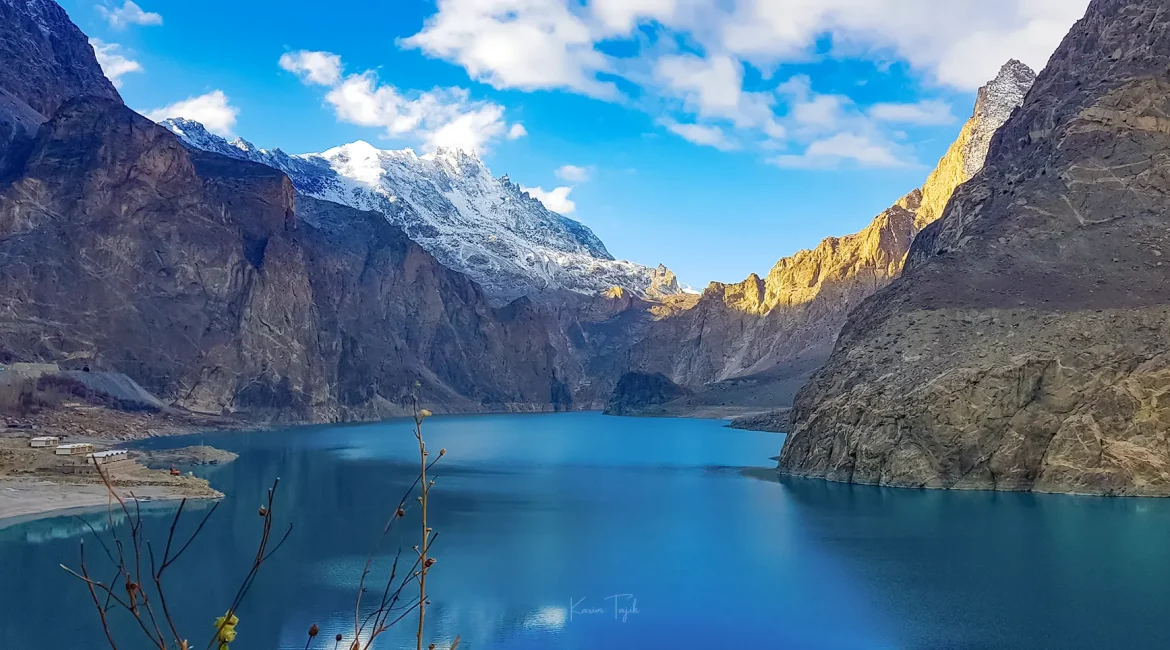Nestled in the Karakoram Mountains, Attabad Lake was formed by a 2010 landslide and is now a stunning turquoise gem and top tourist spot in Hunza Valley.
The Genesis: A Natural Catastrophe
On 4 January 2010, an enormous landslide hit the Attabad village, damming the Hunza River. The natural dam resulted in the formation of a lake spanning more than 21 kilometers in length and up to 100 meters in depth. The tragedy submerged some villages, displaced thousands of people, and interrupted the critical Karakoram Highway. Nevertheless, with time, the lake developed into a symbol of strength and natural beauty.
A Visual Masterpiece
The striking blue waters of Attabad Lake, against the backdrop of rugged mountains, present a visual treat to tourists. The tranquility of the lake and surrounding scenery make it a photographer’s paradise, nature lovers’ delight, and a seekers’ haven in the lap of nature.

Activities and Adventures
Tourists to Attabad Lake can indulge in a range of activities:
Boating & Jet Skiing: Soar across the tranquil waters, soaking up scenic vistas of the peaks surrounding you.
Fishing: The lake is teeming with different fish varieties, and fishing here is a peaceful experience.
Camping: Pitch camp on the lakeshore and spend nights star-gazing under the fresh mountain air.
Hiking & Trekking: Take trekking trails that provide picturesque views of the valley and lake.
Ice Skating: During winter, the ice covering over the lake makes a natural skating rink for skating lovers.
Infrastructure and Accessibility
The creation of Attabad Lake covered sections of the Karakoram Highway, an important trade link between Pakistan and China. It responded to the construction of the Pakistan-China Friendship Tunnels—a chain of five 7-kilometer-long tunnels opened in 2015. Not only did the tunnels reconnect the area but also served as an engineering wonder that improved the accessibility of the region.
Increased tourism has resulted in the construction of numerous resorts and guesthouses around the lake, from high-end resorts to intimate guesthouses. The tourists are able to taste local Hunza foods such as Chapshuro, Hunza bread, and apricot-based items, giving a glimpse of the rich heritage of food in the region.
Cultural Experiences
Attabad Lake is not only a nature paradise; it is also a doorway to the rich culture of the Hunza Valley. Tourists have the opportunity to indulge in local culture, music, and festivals, learning about the lives of the friendly Hunza people.
Environmental Considerations
Tourism has benefited the economy but has also introduced environmental issues:
Pollution: More visitors have created worries about how to dispose of waste.
Deforestation: Infrastructure development has resulted in the clearing of forested areas.
Efforts are underway to promote sustainable tourism, emphasizing the importance of preserving the lake’s pristine environment for future generations.
Best Time to Visit
Spring to Autumn (April to October): Ideal for boating, hiking, and enjoying the lake’s vibrant hues.
Winter (November to March): Enjoy the peaceful charm of the snow landscape and engage in ice skating on the frozen lake.
Close-by Attractions
Make your trip a better one by visiting close-by attractions:
Passu Cones: Tip-like peaks that give beautiful photo opportunities.
Hussaini Suspension Bridge: Nicknamed one of the most dangerous bridges, it’s a dream come true for adventure-lovers.
Baltit and Altit Forts: Historical forts highlighting the area’s rich heritage.
Conclusion
Attabad Lake is a poignant reflection of the ambivalent ability of nature to destroy and be beautiful. From its disastrous beginning to its present status as a symbol of tourism and culture, the lake reflects the essence of resilience. Whether you’re looking for adventure, peace, or cultural enrichment, Attabad Lake in Hunza provides an experience that you will never forget.
Experience the journey to Attabad Lake and see the beautiful mix of nature’s grandeur and human determination.
